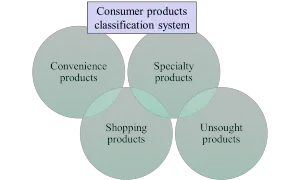Please note that this is one article on the consumer products classification system, which discusses why this classification system is helpful. There are also other articles on this website that discuss how products are classified and how the system guides marketing mix decisions – also please refer to Related Topics below.
Most marketing textbooks will classify consumer products into four categories, namely:
- Convenience products
- Shopping products
- Specialty products
- Unsought products
Main Purpose of the Model
The purpose of this product classification exercise is to group similar types of products together. This will allow a marketer to consider how other products, often outside of their own industry, are marketed – that is, how the 4P’s are constructed. This essentially gives the marketer a set of guidelines on how to structure and marketing mix for a particular type of product.
Outside Learnings
This has a significant advantage to establishing an appropriate marketing mix (that is, a marketing strategy) because the marketer can observe and learn from initiatives outside their direct industry, but for products that have similar characteristics and consumer behavior patterns. This should lead to greater innovation and reduce the likelihood of an inefficient marketing mix.
For example, a marketer of soft drinks could observe how the marketer of candy bars approaches the marketing mix. Although they are not direct competitors, they would still face similar marketing challenges – and a successful campaign in one industry could be easily adopted in another industry. Likewise, a charity organization (an unsought good) could consider marketing initiatives undertaken in the insurance market (also an unsought good) for ideas for their own marketing programs.
Understanding Consumer Behavior
This consumer product classification system is not only based upon elements of the product design/attributes, but is also highly based upon the consumer’s interaction with the product. That is, the choice of retailers, whether the consumer will shop around, the level of information obtained prior to purchase, importance of brand, price point, and so on. As you can see, the consumer product classification system is based on all four elements of the marketing mix.
Related topics
The consumer products classification system
How products are classified in the consumer products classification system
Examples of the different classes in the consumer products classification system
The marketing mix for convenience products
The marketing mix for shopping products
The marketing mix for specialty products
The marketing mix for unsought products

